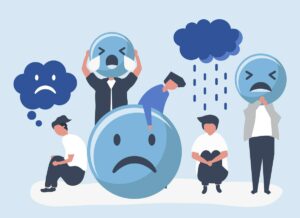Bipolar affective disorder, also known as bipolar disorder, is a mental illness that causes extreme mood swings. These mood swings can go from feeling really high and happy to feeling really low and depressed. Bipolar disorder can be very disruptive to a person’s life and can cause problems in relationships, school, and work. In this blog post, we will discuss everything you need to know about bipolar disorder!
Contents
What is Bipolar Affective Disorder?
 The bipolar affective disorder is a mental illness that causes extreme mood swings. The highs, or mania, can be very intense and last for long periods of time. The lows, or depression, can be just as intense and last for weeks or even months.
The bipolar affective disorder is a mental illness that causes extreme mood swings. The highs, or mania, can be very intense and last for long periods of time. The lows, or depression, can be just as intense and last for weeks or even months.
This condition is described by psychiatrists as a “mood disorder” because the person’s mood swings from one extreme to the other. More often than not, the person will experience more lows than highs.
The bipolar affective disorder is also known as manic depression or simply, bipolar disorder. It affects both men and women equally and usually starts in the late teens or early adulthood. More often than not, it is a lifelong condition that requires treatment. There are two types of bipolar disorder, type I and type II.
Type I is characterized by more extreme highs, or mania, while type II is characterized by less extreme highs or hypomania. And the affective disorder is basically defined by these extreme mood swings.
The disorder can be mild, moderate, or severe and is often accompanied by other mental health disorders such as anxiety or substance abuse. If you think you may be suffering from the bipolar affective disorder, it’s important to seek professional help.
What Are The Symptoms Of Bipolar Affective Disorder?
There are four main symptoms of bipolar affective disorder:
Mania
This is when a person experiences an abnormally high mood, which can last for days or weeks. During this time, they may have very little need for sleep, be full of energy, and be overly confident. More often, mania is associated with risky behavior, such as spending sprees, impulsive decisions, and promiscuous sex.
Depression
Depression is a symptom marked by low mood, fatigue, and loss of interest in activities. People with bipolar disorder can also experience feelings of worthlessness, guilt, and emptiness. More often, it is associated with oversleeping, poor appetite, and difficulty concentrating. This can even lead to suicidal thoughts and behaviors.
Psychosis
This is when a person experiences delusions or hallucinations. For example, they may believe that they are being followed or that someone is out to get them. It is a condition that is often associated with schizophrenia. The signs of psychosis are usually first seen in adolescence or early adulthood. Also, the hallucinations and delusions can be extremely vivid and believable. People with bipolar disorder may also experience what is known as “mixed states.”
Mood swings
 Mood swings are a common symptom of bipolar affective disorder. They can range from the lows of depression to the highs of mania or hypomania. The mood swings can be so severe that they interfere with a person’s ability to function on a day-to-day basis. Some common mood swings you can experience are:
Mood swings are a common symptom of bipolar affective disorder. They can range from the lows of depression to the highs of mania or hypomania. The mood swings can be so severe that they interfere with a person’s ability to function on a day-to-day basis. Some common mood swings you can experience are:
- feeling hopeless or helpless
- feeling irritable, agitated, or tense
- having difficulty concentrating
- having Racing thoughts
- being easily distracted
- sleeping too much or too little
The bipolar affective disorder is a mental illness that is characterized by extreme mood swings. In fact, the name “bipolar” comes from the fact that there are two poles, or extremes, of mood. The low pole is depression and the high pole is mania. In between these two poles is a normal range of mood and behavior.
These are some symptoms and signs that may indicate that you have bipolar disorder. If you are experiencing any of these symptoms, it is important to seek professional help. Bipolar disorder is a treatable condition, and with the right treatment, you can live a full and healthy life.
What Causes This Disorder?
 When you are diagnosed with bipolar disorder, it means that you have experienced at least one manic episode. A manic episode is when you have a period of abnormally high energy levels, mood, and activity.
When you are diagnosed with bipolar disorder, it means that you have experienced at least one manic episode. A manic episode is when you have a period of abnormally high energy levels, mood, and activity.
You may feel like you can do anything and be anyone. You may also take unnecessary risks, such as spending sprees or unprotected sex.
The causes of bipolar affective disorder can be numerous, some of the common causes are listed below:
–Genetics: If you have a family member with bipolar disorder, you are more likely to develop the condition.
–Brain structure: People with bipolar disorder tend to have changes in the regions of their brain that control emotion.
–Stressful life events: Things like the death of a loved one, job loss, or financial problems can trigger bipolar disorder.
–Substance abuse: Drug and alcohol abuse can lead to bipolar disorder. In fact, substance abuse can be both a cause and a symptom of bipolar disorder.
Bipolar disorder is a complex condition, and it is not fully understood. However, there are some risk factors that may make you more likely to develop this condition.
If you think you may be at risk for developing bipolar disorder, it is important to talk to your doctor. They can help you make a plan to manage your symptoms and get the treatment you need. It is important to remember that bipolar disorder is a treatable condition. With the right treatment, you can live a full and healthy life.
How To Diagnose It?
The diagnosis of mental disorders is actually not as simple as many people think. There is no one test that can be done to diagnose someone with a mental disorder. Instead, it is a combination of an interview with the person, as well as observations by family and friends. Here are some ways of diagnosing bipolar disorder:
- Clinical interview: This is a conversation between the mental health professional and the person being diagnosed. The interview will cover topics such as the person’s mood, thoughts, behavior, and any other symptoms that are present.
- Psychological testing: These tests are used to assess a person’s thinking, feeling, and behavior patterns. They can help to rule out other mental disorders that may be causing the symptoms.
- Medical exam: A physical exam can help to rule out any other medical conditions that may be causing the symptoms. The doctor will also check for any signs of substance abuse.
- Laboratory tests: These tests are used to look for any biochemical imbalances in the brain that may be causing the symptoms.
- Imaging studies: These tests can help to rule out any other medical conditions that may be causing the symptoms. They can also show any changes in the brain that may be associated with bipolar disorder.
Once all of this information has been gathered, the mental health professional will make a diagnosis based on the criteria in the Diagnostic and Statistical Manual of Mental Disorders (DSM). The DSM is a guide that mental health professionals use to diagnose mental disorders. It contains a list of symptoms that must be present in order for a diagnosis to be made. If you think that you or someone you know may have bipolar disorder, it is important to seek help from a mental health professional.
How To Treat Bipolar Affective Disorder?
 When the conditions seem to be out of control, it is important to get the right treatment. Here are some common treatment options:
When the conditions seem to be out of control, it is important to get the right treatment. Here are some common treatment options:
Psychotherapy
Psychotherapy is also known as talk therapy. It is a process where you talk to a mental health professional about your thoughts, feelings, and behaviors. This can help you learn how to deal with the symptoms of bipolar affective disorder.
This therapy works best when it is combined with medication. There are many types of psychotherapy, but the most common one used to treat bipolar disorder is cognitive-behavioral therapy (CBT).
CBT helps you understand how your thoughts and behaviors affect each other. It also teaches you how to change these patterns. This can help you manage your symptoms better. Some other types of psychotherapy include:
- Interpersonal therapy
- Family-focused therapy
- Group therapy
These options can be helpful, but it is important to remember that there is no one-size-fits-all approach to treatment. You should work with your mental health professional to find the best treatment plan for you.
Medication
There are many different types of medication that can be used to treat the bipolar affective disorder. The most common type of medication is mood stabilizers. These can help to control the highs and lows of bipolar disorder. Other types of medication that may be used include:
- Antipsychotics
- Antidepressants
- Anti-anxiety medications
It is important to work with a mental health professional to find the right medication for you. These work through a variety of mechanisms, so finding the one that best helps your particular case is essential.
Medications are believed to have side effects. The most common ones are weight gain, sexual dysfunction, and fatigue. In some cases, the side effects may be more severe. If you experience any serious side effects from your medication, be sure to speak with your doctor.
Support Groups
 This is often the first step in managing bipolar disorder. It can be difficult to manage bipolar disorder on your own, and support groups provide a space for you to share your experiences with others who understand what you’re going through. There are many different types of support groups available, so it’s important to find one that feels right for you.
This is often the first step in managing bipolar disorder. It can be difficult to manage bipolar disorder on your own, and support groups provide a space for you to share your experiences with others who understand what you’re going through. There are many different types of support groups available, so it’s important to find one that feels right for you.
In addition, to support groups, there are also online resources and helplines that can be valuable resources. These can provide support and information when you need it most. If you think you may be suffering from bipolar disorder, it’s important to seek professional help. This is the only way to get an accurate diagnosis and begin treatment.
So, these are some basics about bipolar disorder. Remember, if you think you may be suffering from this condition, it’s important to seek professional help. There are many resources available to help you manage the condition and live a fulfilling life.
Is it Possible to Prevent The Disorder?
The prevention is usually done by early detection and treatment of the person who is at risk for developing the disorder. But yes it is possible to prevent it.
The most important thing is to get the person into treatment as soon as possible. If you think that someone you know may be suffering from the bipolar affective disorder, don’t wait for them to ask for help – offer it instead.
Moreover, here are some tips that can prevent the disorder:
- Educate yourself and your loved ones about the disorder
- Be supportive of those who suffer from the disorder
- Encourage them to seek professional help
- Make sure that they stick to their treatment plan
With these things in mind, we can prevent bipolar affective disorder from happening. But, if it does happen, we can still help the person suffering from it. They just need our support.
This disorder is not something that will go away on its own – it requires professional help and treatment. But with the right support, people with the bipolar affective disorder can lead happy and successful lives. You just need to be there for them.
Conclusion
To conclude, the bipolar affective disorder is a mental illness that is characterized by extreme mood swings. If you or someone you know is suffering from this disorder, it is important to seek professional help. While there is no cure for bipolar affective disorder, with proper treatment, people with this disorder can live healthy and productive lives.
For more information, please contact MantraCare. Bipolar disorder is a mental illness characterized by extreme shifts in mood, energy, and activity levels. If you have any queries regarding Online Bipolar Disorder Counseling experienced therapists at MantraCare can help: Book a trial Bipolar Disorder therapy session


